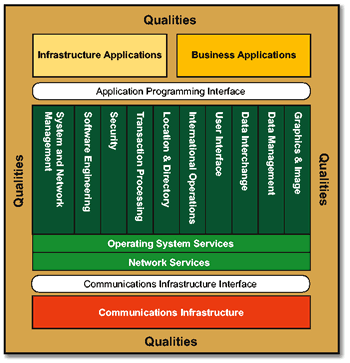Introduction
In the ever-evolving world of enterprise architecture, organizations seek frameworks that provide structure, guidance, and adaptability. The Open Group Architecture Framework (TOGAF) stands out as a comprehensive methodology for developing and managing enterprise architectures. One key aspect of TOGAF is its Reference Models, which serve as fundamental pillars for constructing robust and effective enterprise architectures. In this article, we delve into the TOGAF Reference Models, focusing on the TOGAF Foundation Architecture Technical Reference Model and the Integrated Information Infrastructure Reference Model (III-RM).

TOGAF Foundation Architecture Technical Reference Model
At the core of TOGAF is the Foundation Architecture Technical Reference Model. Think of it as the bedrock upon which the entire enterprise architecture is built. This reference model is a carefully crafted architecture of generic services and functions that provide the necessary groundwork for the development of specific architectures and Architecture Building Blocks (ABBs). ABBs are the elemental components used to construct enterprise architectures, and the Technical Reference Model offers a standardized framework for their creation.
The TOGAF Foundation Architecture Technical Reference Model provides a common language and structure for architects to communicate and collaborate effectively. It serves as a blueprint that allows organizations to align their IT infrastructure and business processes with a shared understanding of essential services and functions. This alignment not only enhances consistency across the enterprise but also facilitates interoperability and integration of diverse systems.
Integrated Information Infrastructure Reference Model (III-RM)
Building upon the Foundation Architecture, the Integrated Information Infrastructure Reference Model (III-RM) is a specialized framework designed to support the vision of Boundaryless Information Flow. In today’s interconnected and data-driven landscape, the ability to seamlessly exchange information across organizational boundaries is crucial. The III-RM addresses this need by providing a structured approach to designing architectures that enable and support the flow of information without constraints.
The III-RM is a powerful tool for architects navigating the challenges of information management and exchange. It takes into account the diverse components involved in information flow, including data, applications, and technology infrastructure. By leveraging the III-RM, organizations can design architectures that promote agility, responsiveness, and collaboration.
Practical Applications
Both the TOGAF Foundation Architecture Technical Reference Model and the Integrated Information Infrastructure Reference Model offer practical applications for enterprises striving to enhance their architecture development processes.
1. Consistency and Standardization: The Technical Reference Model establishes a foundation for consistent architecture development by providing a common set of services and functions. This standardization ensures that architects across the organization speak the same language and follow a cohesive approach.
2. Flexibility and Adaptability: The III-RM, by addressing the challenges of information flow, enables organizations to adapt to changing business requirements. As technology evolves and new opportunities arise, architectures built on the III-RM can easily incorporate innovations while maintaining a coherent structure.
3. Interoperability and Collaboration: Both reference models promote interoperability by providing a shared framework for designing architectures. This facilitates seamless collaboration between different departments and external partners, fostering a Boundaryless Information Flow environment.
Conclusion
In the dynamic landscape of enterprise architecture, the TOGAF Reference Models serve as invaluable tools for organizations aiming to build robust, flexible, and interoperable architectures. The Foundation Architecture Technical Reference Model lays the groundwork for specific architecture development, ensuring a standardized and consistent approach. Meanwhile, the Integrated Information Infrastructure Reference Model focuses on breaking down barriers to information flow, supporting organizations in their quest for a truly interconnected and collaborative environment. By incorporating these reference models into their enterprise architecture practices, organizations can navigate the complexities of modern business with confidence and agility.